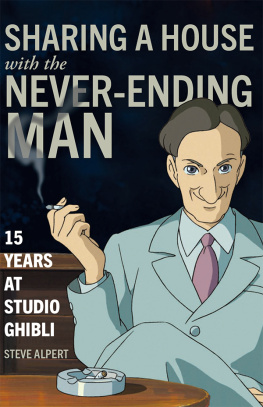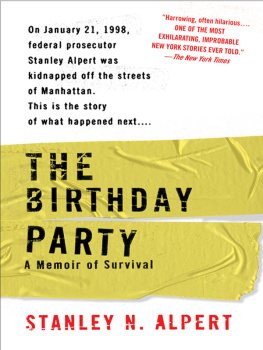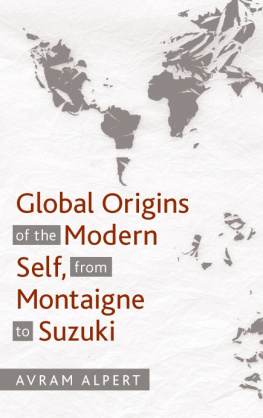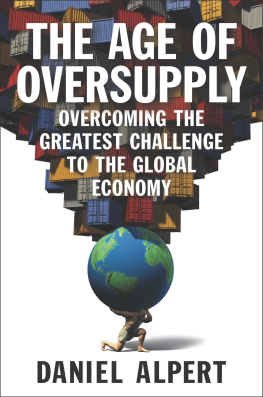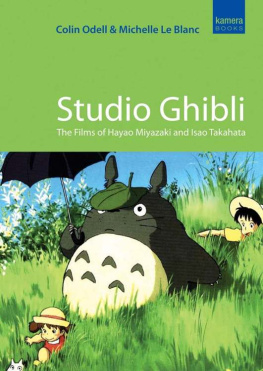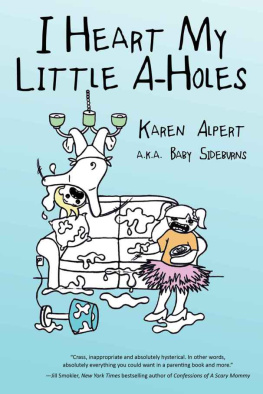Steve Alpert - Sharing a House with the Never-Ending Man: 15 Years at Studio Ghibli
Here you can read online Steve Alpert - Sharing a House with the Never-Ending Man: 15 Years at Studio Ghibli full text of the book (entire story) in english for free. Download pdf and epub, get meaning, cover and reviews about this ebook. year: 2020, publisher: Stone Bridge Press, genre: Detective and thriller. Description of the work, (preface) as well as reviews are available. Best literature library LitArk.com created for fans of good reading and offers a wide selection of genres:
Romance novel
Science fiction
Adventure
Detective
Science
History
Home and family
Prose
Art
Politics
Computer
Non-fiction
Religion
Business
Children
Humor
Choose a favorite category and find really read worthwhile books. Enjoy immersion in the world of imagination, feel the emotions of the characters or learn something new for yourself, make an fascinating discovery.
- Book:Sharing a House with the Never-Ending Man: 15 Years at Studio Ghibli
- Author:
- Publisher:Stone Bridge Press
- Genre:
- Year:2020
- Rating:5 / 5
- Favourites:Add to favourites
- Your mark:
- 100
- 1
- 2
- 3
- 4
- 5
Sharing a House with the Never-Ending Man: 15 Years at Studio Ghibli: summary, description and annotation
We offer to read an annotation, description, summary or preface (depends on what the author of the book "Sharing a House with the Never-Ending Man: 15 Years at Studio Ghibli" wrote himself). If you haven't found the necessary information about the book — write in the comments, we will try to find it.
Steve Alpert: author's other books
Who wrote Sharing a House with the Never-Ending Man: 15 Years at Studio Ghibli? Find out the surname, the name of the author of the book and a list of all author's works by series.
Sharing a House with the Never-Ending Man: 15 Years at Studio Ghibli — read online for free the complete book (whole text) full work
Below is the text of the book, divided by pages. System saving the place of the last page read, allows you to conveniently read the book "Sharing a House with the Never-Ending Man: 15 Years at Studio Ghibli" online for free, without having to search again every time where you left off. Put a bookmark, and you can go to the page where you finished reading at any time.
Font size:
Interval:
Bookmark:
ACKNOWLEDGMENTS

The author wishes to thank everyone at Studio Ghibli for their patience, kindness, guidance, and willingness to suffer a clueless gaijin, but especially
Hayao Miyazaki
Toshio Suzuki
Koji Hoshino
Mikiko Takeda
Haruyo Moriyoshi
Shinsuke Nonaka
Yukari Tai
Evan Ma
Nao Amisaki
Seiji Okuda
Isao Takahata and Yasuyoshi Tokuma, who are no longer with us but whose works will live on forever
And my wife Yoko who has put up with me for more than thirty years.


Salaryman
Fools Rush In
I had been working in Tokyo for ten years, most recently at the Walt Disney Company, when Toshio Suzuki, the head of Studio Ghibli and the producer of nearly all of its films, hired me to start up the international division of Studio Ghibli and its parent company, Tokuma Shoten. With few exceptions, Ghiblis films hadnt been released outside of Japan. Suzuki thought it was time Ghiblis films got the international audience they deserved.
But Studio Ghibli had its own nonconventional way of doing things. This was both the reason for its success in Japan and its inability to get its films screened outside of Japan. Suzuki needed a gaijin for his new international division. But he needed more than a gaijin with the appropriate business talents and experience. He needed a gaijin who could appreciate the subtleties of the way Ghibli/Tokuma functioned. I was a graduate student in Japanese literature before I switched to an MBA program, so I fit the bill. Theoretically.
Suzuki was concerned that even a Japanese-speaking gaijin might not be able to function in the pure and thoroughly Japanese environment that was Ghibli/Tokuma. He went to great lengths to insure that my transition to the new company would be smooth. To begin with he established my new division as a completely independent company within the Tokuma Group. The new company was called Tokuma International. Hayao Miyazaki designed our business cards. The logo was an image of Yasuyoshi Tokuma, the chairman of the Tokuma Group, sprouting wings and flying, presumably, out of Japan.
Suzuki at that time seemed to me to be both the busiest person and the person with the most free time on his hands of anyone I had ever met. This, as I would later learn, is what its like to be in the movie business.
Suzuki was based at Studio Ghibli in Higashi Koganei on the western outskirts of Tokyo. He ran the operational side of the studio while also keeping the production of the film on schedule and creatively on track. He provided support and a shoulder to lean on for the films director, Hayao Miyazaki, and he was the person to whom Miyazaki would turn in order to bounce ideas off of. Every time Miyazaki conceived a possible ending for his film, he would seek out Suzuki to get his reaction. If Suzuki approved right away, Miyazaki would discard the idea and begin again.
In addition to his duties at Ghibli, Suzuki was also the number-two man at Tokuma Shoten, a company that had businesses in publishing, movies, music, and computer games. His boss and mentor, Yasuyoshi Tokuma, chairman and sole owner of the parent company, was in his early seventies and had a penchant for causing trouble and creating situations. It was often Suzukis job to unravel the problems his boss had caused. This generally involved many time-consuming meetings and private, in-person visits.
Suzuki lived in central Tokyo and would start his day with a one-hour-plus drive out to Ghibli in suburban Koganei. He would work there for several hours, then drive back into central Tokyo to attend a meeting or meetings in Shinbashi, where Tokuma Shoten was located. Most meetings in Tokyo were followed by a side meeting, or meetings, in a coffee shop or restaurant. Then Suzuki would drive back again to Ghibli to see how Mononoke Hime(Princess Mononoke) was coming along. On some days he would drive back again to Shinbashi for another meeting and then back again to Ghibli. Suzuki often held meetings out at Koganei or back in Tokyo that began at 10 pm and lasted for hours. He usually left the studio at 1 am or 2 am for his drive back home to Tokyo. He rarely slept more than four hours a night.
Suzuki is not a particularly large man, but he radiates a palpable energy, intelligence, and wit. Like Hayao Miyazaki, who is older than Suzuki by about a decade, Suzuki is instantly recognizable by anyone almost anywhere in Japan. His narrow face with John Lennonstyle round glasses and a perpetual five-day beard and his extremely casual style of dress make him look like a person no one would ever mistake for a Japanese salaryman or believe was a director of a major company.
Despite living a good deal of his life in a car or in meeting rooms, Suzuki always had time to see every major Japanese and Hollywood film then playing. He had an unusually thorough and detailed knowledge of the roads, paths, and hidden alleyways of the Koganei-Mitaka area. None of these roads were ones Suzuki would have crossed in his back-and-forth travels between Ghibli and Shinbashi, and they often led to the most interesting hidden parks and special restaurants in the area. For someone so eternally busy, Suzuki managed to spend long periods of time alone and just thinking. He also spent long hours locked in windowless rooms attending to the excruciatingly time-consuming process of filmmaking. And somehow he still found time to mentor the people who worked for him.
The Tokuma Group of companies then consisted of Studio Ghibli (animation), Daiei Pictures (live-action films), Tokuma Publishing (the main company and a large publisher of a range of books from graphic novels to literature, nonfiction, magazines, and even poetry), Tokuma Japan Communications (music), Tokuma Intermedia (computer games and computer game magazines), Toko Tokuma (joint venture movie projects in China and independent films using Chinese directors), and Tokuma International (my company, engaged in sales of Tokumas entertainment products outside of Japan).
When I joined Tokuma International, all media companies in Japan were just beginning to experience the serious challenges to their traditional business models posed by computer-based entertainment products and a decline in the demand for things printed on paper, formerly known as books, magazines, and newspapers. Over at Ghibli, the studios primary creator, Hayao Miyazaki, was simultaneously working himself nearly to death on his new film, PrincessMononoke, and facing a monumental writers block in his struggle to come up with an ending for the film. Miyazaki would always work by writing the endings to his screenplays while the beginning and middle parts of it were already in production. When the production of the film would catch up to the unwritten parts of the screenplay, a general panic would set in. Ghibli produced approximately one film every two years, and to miss a release date could conceivably mean financial ruin for the studio.
With the business problems at Tokuma, the production problems at Ghibli, and the teething problems with the brand new Tokuma/Disney relationship in which Disney had contracted to distribute Ghiblis films worldwide, Suzuki was driving back and forth between Shinbashi and Koganei quite a lot. He therefore spent a good part of his day in his car.
Font size:
Interval:
Bookmark:
Similar books «Sharing a House with the Never-Ending Man: 15 Years at Studio Ghibli»
Look at similar books to Sharing a House with the Never-Ending Man: 15 Years at Studio Ghibli. We have selected literature similar in name and meaning in the hope of providing readers with more options to find new, interesting, not yet read works.
Discussion, reviews of the book Sharing a House with the Never-Ending Man: 15 Years at Studio Ghibli and just readers' own opinions. Leave your comments, write what you think about the work, its meaning or the main characters. Specify what exactly you liked and what you didn't like, and why you think so.

